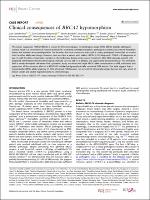Resum
Paraules clau
Càncer de mama; Genètica del càncer
Citació recomanada
Castells-Roca L, Gutiérrez-Enríquez S, Bonache S, Bogliolo M, Carrasco E, Aza-Carmona M, et al. Clinical consequences of BRCA2 hypomorphism. npj Breast Cancer. 2021 Sep 9;7:117.
Audiència
Professionals
Empreu aquest identificador per citar i/o enllaçar aquest document
https://hdl.handle.net/11351/7431Aquest element apareix a les col·leccions següents
- HVH - Articles científics [2966]
- VHIO - Articles científics [864]
Els següents fitxers sobre la llicència estan associats a aquest element:


